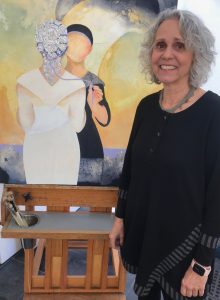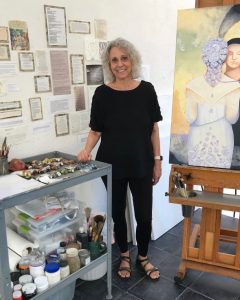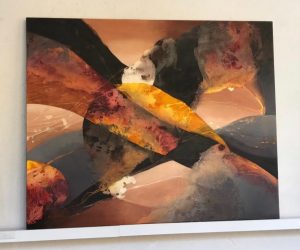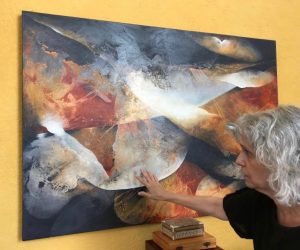What are the chances, I wonder, of moving to another country and finding, quite by accident, that three other people from your little hometown in northern New Jersey, USA — women who actually attended the same high school you did at about the same time — live there now too?
That’s been my happy experience in San Miguel de Allende, Mexico. My “homies” here include retired business executive and active SMA volunteer Suzanne Bacon, watercolor artist and teacher Linda Whynman, and visual artist Kathleen Cammarata – all of whom I’m now getting to know in ways I never did when we were girls growing up in ‘Jersey. It’s been a joy.
In March I attended Kathleen’s last Open Studio of the season at her lovely home in the San Antonio neighborhood of San Miguel. On that occasion I took this photo of her beside one of her works-in-progress at the time, depicting sisters:

She and I subsequently made a plan for me to return as soon as possible to speak with her in more depth about her work and her thoughts about life and art. This week we were able to do that.

I learned that Kathleen, now seventy-two, has been an oil painter since she was thirty-five. Before then she was a children’s book illustrator, while teaching in a Montessori school and raising her two children. She later left the Montessori classroom and moved on to teaching art at two museums and a university. In San Miguel for the past nine years with her husband Frank, she now pursues drawing, oil painting, and mixed mediums full-time.

Sitting with her in her spacious, white, light-filled studio, I asked Kathleen a number of questions, including — because I’m now trying my hand at watercolor painting — her thoughts on the ability of people to learn art later in life.
“Since I’ve taught students from three years old to seventy years old, I believe anybody can learn anything at any age,” she said. “It’s not easy, however. If you want to be a really good piano player, you’re going to have to stay with it for a good ten years. Many people, when they retire, want to start painting, and I think that’s great. Maybe they shouldn’t call themselves artists, though. They should just say, ‘I’m having fun.’ It took me many years before I could call myself an artist.”

I asked her what that discipline entailed.
“If you really want to get there,” she said, “you have to show up every day. It doesn’t mean you have to pick up a brush or a pencil. It just means you have to go into the space and be in the space – like ‘A Room of Her Own’ – and spend time there, whether you’re thinking, meditating, or painting. That’s the main ingredient. … I don’t wait for inspiration to fall out of the sky. Unless I get in here and start looking at past work and materials and tools, nothing will happen.”
And where, I asked her, does she get her inspiration?
“I really believe that one thing feeds the next. So I’m always looking for connections – the connections from my paintings to the drawings and back again, to the next, to the next; the connections with my work and the greater world. And when I see those connections, I start to see what the next thing is. It’s a sense of connection.”
One of the examples of this “connection,” she showed me, was her COVID series. “Due to COVID, we were severed from our family and friends. So once I started this series,” she said, “I knew it had to be two people – one person over here and the other person over there… And then I’d work on that for a while, and then I’d start the next one. And then I looked back at the first one and saw the connection in the paintings.”
Throughout her work on the COVID series, Kathleen told me, she was motivated by the question, What can art bring to the problem?
“I’m not a doctor, I’m not a nurse, I’m not a political person who can mandate mask-wearing,” she said. “So I had to ask myself, ‘What can artists do in the middle of a pandemic to help people see their way through?’ Then I created the series and posted each one on Facebook. That was a particular calling to address the pandemic.”
Another example is her series called Hemisphere. “How can I as an artist address the issue of climate change?” she asked rhetorically. “I’m still trying to answer that question. I believe if we really understood the vastness of the whole universe and all the things in it and how each thing impacts another, then maybe we would have much more respect for our ground and sky.”

When I asked what she felt was her biggest accomplishment, Kathleen told me her ultimate goal has always been to have her paintings in a museum one day. “That would be my biggest accomplishment,” she said. “I haven’t achieved it yet. … In the past, women artists represented only about 10 percent of the art in museums. It’s something like 40 percent now. But we still have a ways to go.”

Finally, as I do in all WOW interviews, I asked Kathleen what she’d like her legacy to be.
“I’d like to think that I’ve inspired other people to be creative,” she said. “Not necessarily artists, just be creative. Creativity is a way of connecting with the world.”
~ ~ ~ ~ ~ ~
Kathleen plans to resume her Open Studios in September. Before then, if you’d like to see all of her work in her beautiful studio, you can email her for an appointment at katcammarata@gmail.com or message her on Facebook.
